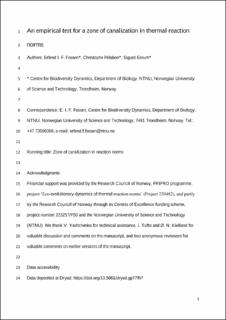An empirical test for a zone of canalization in thermal reaction norms
Journal article, Peer reviewed
Accepted version
Permanent lenke
https://hdl.handle.net/11250/2989610Utgivelsesdato
2018Metadata
Vis full innførselSamlinger
- Institutt for biologi [2575]
- Publikasjoner fra CRIStin - NTNU [38127]
Sammendrag
Theoretical models on the evolution of phenotypic plasticity predict a zone of canalization where reaction norms cross, and genetic variation is minimized in the environment a population most frequently encounter. Empirical tests of this prediction are largely missing, in particular for life-history traits. We addressed this prediction by quantifying thermal reaction norms of three life-history traits (somatic growth rate, age and size at maturation) of a Norwegian population of Daphnia magna and testing for the occurrence of an intermediate temperature (Tm) at which genetic variance in the traits is minimized. Size at maturation changed relatively little with temperature compared to the other traits, and there was no genetic variance in the shape of the reaction norm. Consequently, age at maturation and somatic growth rate were strongly negatively correlated. Both traits showed a strong genotype–environment interaction, and the estimated Tm was 14 °C for both age at maturation and growth rate. This value of Tm corresponds well with mean summer temperatures experienced by the population and suggests that the population has evolved under stabilizing selection in temperatures that fluctuate around this mean temperature. These results suggest local adaptation to temperature in the studied population and allow predicting evolutionary trajectories of thermal reaction norms under changing thermal regimes.
